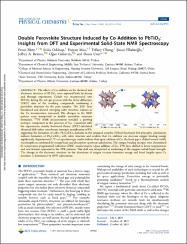Double perovskite structure induced by co addition to pbtio3: Insights from dft and experimental solid-state NMR spectroscopy

View/
Access
info:eu-repo/semantics/openAccessDate
2019Author
Mete, ErsenOdabaşı, Selda
Mao, Haiyan
Chung, Tiffany
Ellialtıoğlu, Şinasi
Reimer, Jeffrey A.
Gülseren, Oğuz
Üner, Deniz
Metadata
Show full item recordAbstract
The effects of Co addition on the chemical and electronic structure of PbTiO3 were explored both by theory and through experiment. Cobalt was incorporated into PbTiO3 during the sol-gel process with the X-ray diffraction (XRD) data of the resulting compounds confirming a perovskite structure for the pure samples. The XRD lines broadened and showed emerging cubic structure features as the Co incorporation increased. The changes in the XRD pattern were interpreted as double perovskite structure formation. Pb-207 NMR measurements revealed a growing isotropic component in the presence of Co. Consistent with the experiments, density functional theory (DFT)-calculated chemical-shift values corroborate isotropic coordination of Pb, suggesting the formation of cubic Pb2CoTiO6 domains in the prepared samples. Hybrid functional first-principles calculations indicate formation of Pb2CoTiO6 with cubic structure and confirm that Co addition can decrease oxygen binding energy significantly. Experimental UV-vis spectroscopy results indicate that upon addition of Co, the band gap is shifted toward visible wavelengths as confirmed by energy band and absorption spectrum calculations. The oxygen binding energies were determined by temperature-programmed reduction (TPR) measurements. Upon addition of Co, TPR lines shifted to lower temperatures and new features appeared in the TPR patterns. This shift was interpreted as weakening of the oxygen-cobalt bond strength. The change in the electronic structure by the alterations of oxygen vacancy formation energy and bond lengths upon Co insertion is determined by DFT calculations.

















